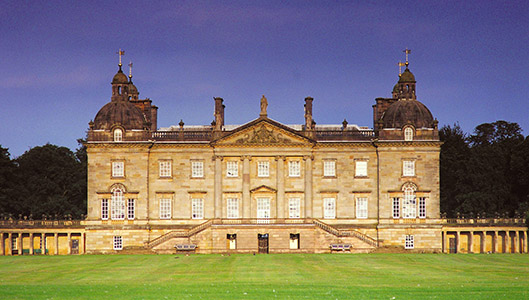Nostalgia, it would seem, is the very foundation of our holiday season and its many traditions. Two wholly different exhibitions in San Francisco illustrate how “aspirational art” was displayed in two distinct eras.

The Houghton Hall exhibition at the Legion of Honor features a wonderful array of objects from one of Britain’s great country estates. Photo by Nick McCann
By Paul Duclos
Published: December, 2014
Nostalgia, it would seem, is the very foundation of our holiday season and its many traditions. Two wholly different exhibitions in San Francisco illustrate how “aspirational art” was displayed in two distinct eras.
Loved Downton Abbey? Then be sure not to miss the curated Edwardian blockbuster at the Legion of Honor, Houghton Hall.
This portrait of an English country house is drawn from the collections of an entire community. Built in Norfolk in the 1720s for England’s first prime minister, Sir Robert Walpole, Houghton Hall features suites of grand rooms conceived by architect William Kent as settings for Walpole’s old master paintings, furniture, tapestries and Roman antiquities.
“Houghton Hall brings to San Francisco a wonderful array of objects from one of Britain’s great country houses and reflects the history of this magnificent estate across nearly 300 years, from the 18th century to the present day. It is particularly fitting that this exhibition is being displayed at the Legion of Honor, complementing our recently reinstalled collection of British paintings and decorative arts,” said Colin B. Bailey, director of the Fine Arts Museums of San Francisco.
The exhibition tells the story of the structure and its inhabitants through displays that convey key architectural spaces, such as the impressive double-height stone hall of marble, stucco and silver limestone; the grand state saloon, upholstered in red velvet; and the more restrained wood-paneled library, which served as Walpole’s office away from London. Kent’s architectural drawings, also on view, will reveal the geneses of these interiors, which were inspired by both Renaissance architect Andrea Palladio and the style of Baroque-era Rome.
For more information, see legionofhonor.famsf.org.
Meanwhile, for those who prefer more contemporary sentimentalism, Pier 24 Photography presents Secondhand, an exhibition featuring artists who build repositories of found images, from which they appropriate, construct, edit and sequence in order to create something entirely new. Through this process, their distinctly personal approaches become as wide-ranging as their source material. These works are paired alongside selected vernacular photographs from the Pilara Foundation collection, illustrating another instance in which found pictures can offer new meaning through a simple change of context.
The digital age has ushered in a culture of curating. Blogs, along with websites like Instagram, Facebook, Pinterest and Flickr, enable users not only to produce and disseminate unique content, but also to communicate through the editing, sequencing and selection of existing material. These online platforms have become a way of digesting and understanding the overabundance of visual information circulating daily.
As a result, the definition of the term “curator” has expanded beyond the realm of highly educated art historians to include anyone engaged with organizing content. It is no surprise that this curatorial impulse appears in the practices of many contemporary artists, where the distinction between curator and creator has become less defined.
The pioneering artists John Baldessari (Room 03), Richard Prince (Room 01), Larry Sultan and Mike Mandel (Room 15) began sourcing images from popular culture and government archives in the 1970s and 1980s. Removed from their original contexts, these pictures offer new insight, encouraging viewers to reexamine their relationship to commonplace imagery, while also considering the notion of authorship. The precedent set by these artists empowered the next generation to sample, dissect and reimagine without hesitation, using any available image to create new works of art.
Erik Kessels, whose work is featured here in several large galleries, epitomizes the fluidity of the roles of curator and creator. Kessels has amassed an immense archive of vernacular snapshots and photo albums that he incorporates into his artistic practice. In Album Beauty (Room 09) and in almost every picture (Room 04), he curates from his holdings to suggest universal connections between found images, which, as a result, transcend their personal subject matter. Viewed through his lens, Kessels’ selections speak to the human experience and nod to the power, beauty and materiality of these amateur pictures at a time when images are largely consumed online. In 24 Hrs in Photos (Room 17), he comments directly on the photograph’s role in the digital world by printing every picture that had been uploaded over the course of one day to the photo-sharing website Flickr. Through this installation, the viewer can both visually and physically experience the overwhelming number of photographs shared online.
For more information, see www.pier24.org.

